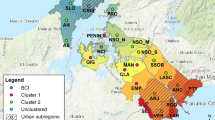Abstract
Recent warming has caused changes in species distribution and abundance1,2,3, but the extent of the effects is unclear. Here we investigate whether such changes in highland forests at Monteverde, Costa Rica, are related to the increase in air temperatures that followed a step-like warming of tropical oceans in 1976 (refs4, 5). Twenty of 50 species of anurans (frogs and toads) in a 30-km2 study area, including the locally endemic golden toad (Bufo periglenes), disappeared following synchronous population crashes in 1987 (6–8). Our results indicate that these crashes probably belong to a constellation of demographic changes that have altered communities of birds, reptiles and amphibians in the area and are linked to recent warming. The changes are all associated with patterns of dry-season mist frequency, which is negatively correlated with sea surface temperatures in the equatorial Pacific and has declined dramatically since the mid-1970s. The biological and climatic patterns suggest that atmospheric warming has raised the average altitude at the base of the orographic cloud bank, as predicted by the lifting-cloud-base hypothesis9,10.
This is a preview of subscription content, access via your institution
Access options
Subscribe to this journal
Receive 51 print issues and online access
$199.00 per year
only $3.90 per issue
Buy this article
- Purchase on Springer Link
- Instant access to full article PDF
Prices may be subject to local taxes which are calculated during checkout




Similar content being viewed by others
References
Parmesan, C. Climate and species' range. Nature 382, 765–766 (1996).
Veit, R. R., McGowan, J. A., Ainley, D. G., Wahls, T. R. & Pyle, P. Apex marine predator declines 90% in association with changing oceanic climate. Global Change Biol. 3, 23–28 (1997).
McGowan, J. A., Cayan, D. R. & Dorman, L. M. Climate–ocean variability and ecosystem response in the northeast Pacific. Science 281, 210–217 (1998).
Trenberth, K. E. & Hurrell, J. W. Decadal atmosphere-ocean variations in the Pacific. Clim. Dyn. 9, 303–319 (1994).
Graham, N. E. Simulation of recent global temperature trends. Science 267, 666–671 (1995).
Pounds, J. A. & Crump, M. L. Amphibian declines and climate disturbance: the case of the golden toad and the harlequin frog. Cons. Biol. 8, 72–85 (1994).
Pounds, J. A., Fogden, M. P. L., Savage, J. M. & Gorman, G. C. Tests of null models for amphibian declines on a tropical mountain. Cons. Biol. 11, 1307–1322 (1997).
Pounds, J. A. in Monteverde: Ecology and Conservation of a Tropical Cloud Forest(eds Nadkarni, N. M.&Wheelwright, N. T.) (Oxford University Press, New York, in press).
Pounds, J. A., Fogden, M. P. L. & Campbell, J. H. in Meeting Report, Bird Life International/WWF Workshop on the Impacts of Climate Change on Flora and Fauna(ed. Briggs, B.) (Royal Society for Protection of Birds, Bedfordshire, UK, 1997).
Still, C. J., Foster, P. N. & Schneider, S. H. Simulating the effects of climate change on tropical montane cloud forests. Nature 398, 608–610 (1999).
Diaz, H. F. & Graham, N. E. Recent changes in tropical freezing heights and the role of sea-surface temperature. Nature 383, 152–155 (1996).
Beniston, M., Diaz, H. F. & Bradley, R. S. Climatic change at high elevation sites: an overview. Clim. Change 36, 233–251 (1997).
Diaz, H. F. & Bradley, R. S. Temperature variations during the last century at high elevation sites. Clim. Change 36, 253–279 (1997).
Thompson, L. G. et al. Late glacial stage and holocene tropical ice core records from Huascarán, Peru. Science 269, 46–50 (1995).
Cavalier, J., Solis, D. & Jaramillo, M. A. Fog interception in montane forests across the Central Cordillera of Panamá. J. Trop. Ecol. 12, 357–369 (1996).
Clark, K. L., Nadkarni, N. M., Schaefer, D. & Gholz, H. Atmospheric deposition and net retention of ions by the canopy in a tropical montane forest, Monteverde, Costa Rica. J. Trop. Ecol. 14, 27–45 (1998).
Karl, T. R. et al. Anew perspective on recent global warming: asymmetric trends of daily maximum and minimum temperatures. Bull. Am. Meteorol. Soc. 74, 1007–1023 (1993).
Gómez, I. E. & Fernandez, W. Variación interannual de la temperatura en Costa Rica. Top. Meteor. Oceanogr. 3, 27–44 (1996).
Karr, J. R. & Freemark, K. E. Habitat selection and environmental gradients: dynamics in the ‘stable’ tropics. Ecology 64, 1481–1494 (1983).
Fogden, M. P. L. An Annotated Checklist of the Birds of Monteverde and Peñas Blancas(Green Mountain, Monteverde, Costa Rica, 1993).
Andrews, R. M. Population stability of a tropical lizard. Ecology 72, 1204–1217 (1991).
Pounds, J. A. Ecomorphology, locomotion, and microhabitat structure: patterns in a tropical mainland Anolis community. Ecol. Monogr. 58, 299–320 (1988).
Laurance, W. F. Catastrophic declines of Australian rainforest frogs: is unusual weather responsible? Biol. Cons. 77, 203–212 (1996).
Crump, M. L. & Pounds, J. A. Lethal parasitism of an aposematic anuran (Atelopus varius) by Notochaeta bufonivora (Diptera: Sarcophagidac). J. Parasitol. 71, 588–591 (1985).
Pounds, J. A. & Crump, M. L. Harlequin frogs along a tropical montane stream: aggregation and the risk of predation by frog-eating flies. Biotropica 19, 306–309 (1987).
Crump, M. L. & Pounds, J. A. Temporal variation in the dispersion of a tropical anuran. Copeia 1989, 209–211 (1989).
Dobson, A. & Carper, R. in Global Warming and Biological Diversity(eds Peters, R. L.&Lovejoy, T. E.) 201–217 (Yale Univ. Press, New Haven, Connecticut, 1992).
Beebee, T. J. C. Amphibian breeding and climate. Nature 374, 219–220 (1995).
Stewart, M. M. Climate driven population fluctuations in rain forest frogs. J. Herpetology 29, 437–446 (1995).
Berger, L. et al. Chytridiomycosis causes amphibian mortality associated with population declines in the rain forests of Australia and Central America. Proc. Natl Acad. Sci. 95, 9031–9036 (1998).
Acknowledgements
We thank C. J. Still, P. N. Foster and S. H. Schneider for sharing their GCM simulations and for their comments on the manuscript; we also thank M. Brenes, R. W. Carlson, P.M.Fogden, G. R. Graves, J. F. Jackson, F. J. Joyce, K. L. Masters, J. M. Savage and N. T. Wheelwright for comments that improved the final version. J.A.P. acknowledges partial support from the MacArthur Foundation, Stanford University's Center for Conservation Biology, the Brookfield Zoo, the University of Miami, the US NSF, the Jessie Smith Noyes Foundation, the Organization for Tropical Studies, the Tropical Science Center and the University of Florida.
Author information
Authors and Affiliations
Corresponding author
Rights and permissions
About this article
Cite this article
Pounds, J., Fogden, M. & Campbell, J. Biological response to climate change on a tropical mountain. Nature 398, 611–615 (1999). https://doi.org/10.1038/19297
Received:
Accepted:
Issue Date:
DOI: https://doi.org/10.1038/19297
This article is cited by
-
Integrating genomics into the genetic management of the endangered mountain yellow-legged frog
Conservation Genetics (2024)
-
Effects of temperature and precipitation changes on shifts in breeding phenology of an endangered toad
Scientific Reports (2023)
-
Climate change in the Central Amazon and its impacts on frog populations
Environmental Monitoring and Assessment (2023)
-
Coexistence with an invasive species in the context of global warming lead to behavioural changes via both hereditary and ontogenetic adjustments to minimise conflict
acta ethologica (2023)
-
Patterns of species richness and beta diversity of vascular plants along elevation gradient in Brazilian páramo
Journal of Mountain Science (2023)
Comments
By submitting a comment you agree to abide by our Terms and Community Guidelines. If you find something abusive or that does not comply with our terms or guidelines please flag it as inappropriate.



